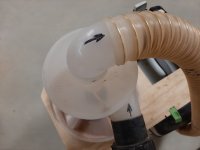This afternoon, I was jointing some southern yellow pine to build a stand for my midi lathe. This wasn't a lot of material - less than 100 sf of material before ripping/crosscutting/etc. By the time i got to the last 8 or so pieces, I noticed the 'problem light' on my Metabo vac flashing, indicating an issue with suction. My jointer is an 8" benchtop model, and I typically take light passes.
After checking the hose for obstructions and ensuring my dust deputy was not full, I checked the vacuum itself and found the inlet fully clogged. Further investigation uncovered that the fleece bag was completely full!
I have a fair number of bags, so I'm not too worried about wasting one, but I am not sure why this would be happening. The dust deputy generally performs like a champ, and I've been using it for four or five years now without issue. I did build a new 'bucket' for it, so I can go longer between emptying it and place a liner in so I can bag up the dust rather than dump it out.
Once I get a new bag in there, I'd prefer it if this doesn't happen again. Does anyone have any suggestions about what I should investigate for the reason it would be failing to divert as much dust as should?
After checking the hose for obstructions and ensuring my dust deputy was not full, I checked the vacuum itself and found the inlet fully clogged. Further investigation uncovered that the fleece bag was completely full!
I have a fair number of bags, so I'm not too worried about wasting one, but I am not sure why this would be happening. The dust deputy generally performs like a champ, and I've been using it for four or five years now without issue. I did build a new 'bucket' for it, so I can go longer between emptying it and place a liner in so I can bag up the dust rather than dump it out.
Once I get a new bag in there, I'd prefer it if this doesn't happen again. Does anyone have any suggestions about what I should investigate for the reason it would be failing to divert as much dust as should?

![shop vac 20200904_144037[1] (Large).jpg](/data/attachments/76/76589-f5122168cdfa16c30a6f0a38703d0c46.jpg?hash=i5nBLGqERg)


